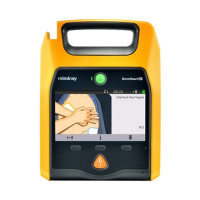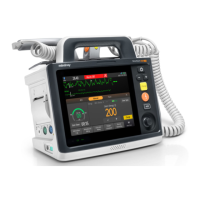13 - 1
13 Monitoring Respiration (Resp)
13.1 Resp Safety Information
• When monitoring the patient’s respiration, do not use ESU-proof ECG cables.
• If you do not set the detection level for the respiration correctly in manual detection mode, it may
not be possible for the equipment to detect apnea. If you set the detection level too low, the
equipment is more likely to detect cardiac activity, and to falsely interpret cardiac activity as
respiratory activity in the case of apnea.
• The respiration measurement does not recognize the cause of apneas. It only indicates an alarm if no
breath is detected when a pre-adjusted time has elapsed since the last detected breath. Therefore, it
cannot be used for diagnostic purpose.
• If operating under conditions according to the EMC Standard IEC 60601-1-2 (Radiated Immunity 3V/
m), field strengths above 3V/m may cause erroneous measurements at various frequencies.
Therefore, it is recommended to avoid the use of electrically radiating equipment in close proximity
to the respiration measurement unit.
• The impedance respiration measurement may cause rate changes in Minute Ventilation Rate
Responsive Pacemakers. Set the pacemaker rate responsive mode off or disable the impedance
respiration measurement on the equipment.
• When using the electrosurgery unit, ensure proper contact of the ESU return electrode to the patient
to avoid burns at measurement sites. Also ensure that the ESU return electrode is near the operating
area.
• Respiration monitoring is not for use on the patients who are very active, as this will cause false
alarms.
13.2 Resp Display
• If ESU-proof ECG cables are used, the Resp waveform area will display the message “Check Leads”.
Replace the ECG cable if necessary.
13.3 Preparing for Resp Monitoring
13.3.1 Placing the Electrodes
• To reduce cardiovascular artifact, apply the respiration electrodes so that the liver area and the
ventricles of the heart are not in the line between the respiratory electrodes. This is especially
important for neonatal patients.
• To optimize the respiration waveform, place the RA and LA electrodes horizontally when monitoring
respiration with ECG Lead I; place the RA and LL electrodes diagonally when monitoring respiration
with ECG Lead II.
• To optimize respiratory waveforms for patients breathing mainly abdominally, apply the LL
electrode on the left abdomen at the point of maximum abdominal expansion.

